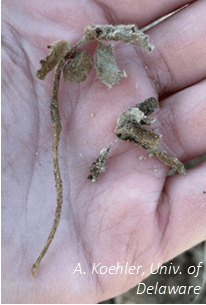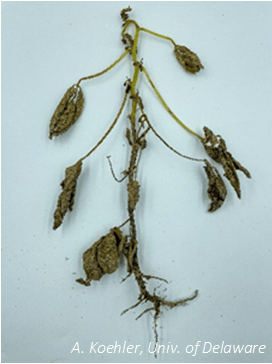Alyssa Koehler, Extension Field Crop Pathologist | akoehler@udel.edu
University of Delaware
Seedling diseases are common across many crops, including soybeans. The most common seedling pathogens Pythium spp., Phytophthora sojae, Fusarium spp., and Rhizoctonia solani are often naturally present in the field, but certain environments, like compacted, wet, or poorly-drained soils and cool weather that slows emergence can favor disease development. Infected seedlings may fail to emerge before coming out of the ground (pre-emergence damping off) or die after coming out of the ground (post-emergence damping off), surviving plants may appear stunted with other symptoms visible on the seedling.
Pythium spp. can cause pre- and post-emergence damping off. Development of Pythium is favored by wet soils and we have species in the area that favor both cool and warm weather. Tissue will be brown in color and appear soft and rotting. This can look very similar to Phytophthora in seedlings, but can be confirmed by submitting a sample to the diagnostic lab. Surviving plants may be stunted and have less vigor.

Phytophthora is also able to cause pre-and post-emergence damping off. Tissue will be soft and tan-brown in color. Stems may look bruised and with rotten roots, plants will usually wilt and die. It is also possible to see Phytophthora symptoms develop mid to end of season. Later in the season, dark brown discoloration of the stem will extend from just below the soil line up into the plant (Figure 2).

Rhizoctonia can cause damage pre- or post-emergence. Often rust-brown lesions will be present on the roots or lower stems. In some cases this may girdle the stem stunting or killing the plant.
Fusarium spp. can infect the seed or seedling. There will often be brown lesions on the roots and the root system may appear shrunken. Numerous Fusarium species can be associated with root rot of soybean. Another soybean disease, Soybean Sudden Death (SDS), is caused by Fusarium virguliforme. While F. virguliforme will infect early in the season, symptom of SDS do not become present until the plant reaches reproduction stages.
Seed and seedling diseases can be difficult to manage. Waiting for fields to be relatively dry and delaying planting until soils are warmer than 55°F can favor quicker emergence and growth, which can be beneficial. Genetic resistance is available for managing Phytophthora. Fungicide seed treatments may reduce seed and seedling diseases. In our work over the past three seasons, we have observed faster emergence and improved stand when using seed treatments in April planted soybeans. Although collectively called fungicides, not all fungicide products are effective against all pathogens. Pythium and Phytophthora are fungal-like organisms called oomycetes. Active ingredients, mefenoxam and metalaxyl, have activity on oomycetes, while strobilurins (azoxystrobin, trifloxystrobin, pyraclostrobin, etc.) have activity on Fusarium and Rhizoctonia. For this reason, seed treatments typically have two or more active ingredients. Each year the Crop Protection Network releases a “Fungicide Efficacy for Control of Soybean Seedling Diseases” publication to aid in decision making for seed treatments. The full publication can be found at https://cropprotectionnetwork.org/publications/fungicide-efficacy-for-control-of-soybean-seedling-diseases.
